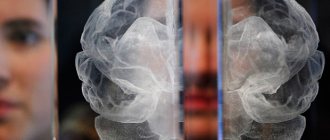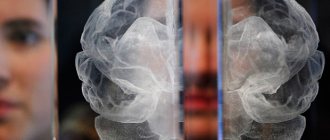Psychopathy is characterized by features that have diagnostic significance - such as external charm, high intelligence, poor judgment, inability to learn from experience, pathological egocentrism, lack of capacity to love, inability to feel remorse or shame, impulsivity, grandiose sense of self-worth, pathological deceit, manipulative behavior, poor self-control, sexual promiscuity, delinquent behavior in adolescence, and greater criminality and versatility, among others (Cleckley, 1982; Hare et al., 1990). As a consequence of these criteria, the psychopath has the image of a cold, heartless, inhumane being. But do all psychopaths have a total lack of normal depth of feeling and empathy? Like healthy people, many psychopaths love their parents, spouses, children, and pets in their own way, but have difficulty loving and trusting the rest of the world. In addition, psychopaths do experience emotional distress due to separation, divorce, death of a loved one, or dissatisfaction with their own deviant behavior (Martens, 1997).
Sources of sadness
Psychopaths may experience emotional pain for a variety of reasons. Like other people, psychopaths have a deep need for love and care. However, this desire often goes unsatisfied because it is very difficult for the other person to be around someone who has such a repulsive character. Psychopaths are at least periodically aware of how others see them and may be genuinely saddened by their inability to control their own behavior. The lives of most psychopaths are devoid of stable social connections and warm, close relationships.
The life histories of psychopaths are often characterized by chaotic family life, lack of parental attention and guidance, parental chemical dependency or antisocial behavior, poor relationships, divorce, and living in socially disadvantaged areas (Martens, 2000). They may feel that they are prisoners of their own etiological predetermination and believe that they have, compared to normal people, fewer opportunities and advantages in life.
Despite their outward arrogance, psychopaths internally feel “nastier” than others, and know that the reason for this is their own behavior. Although some psychopaths are superficially well-adjusted and even popular, they feel that they must carefully hide their true colors because they will not be accepted by others. This leaves psychopaths with a difficult choice: either adapt and live an empty, unrealistic life, or not adapt and live alone, isolated from other people. Psychopaths see all the time how other people love each other, care about each other; they are depressed by the knowledge that they can never be the objects of such relationships.
Psychopaths are known for their need for extreme stimulation, but the most reckless adventures end only in disappointment due to conflicts with others and unrealistic expectations. In addition, many psychopaths are discouraged by their inability to control the craving for intense sensations, in the process of which they are constantly faced with their own helplessness. Psychopaths may try to change, but the reduced ability to experience fear and the associated inability to learn from experience leads to repeated negative experiences, confrontations with frustration and depression, including problems with the justice system.
Over time, psychopaths become unable to continue such an energy-intensive lifestyle and become “burnt out” and depressed. If they look back on their hectic lives, they will see that it is full of interpersonal dissatisfaction. Their health deteriorates as the effects of their reckless behavior accumulate.
Clinical variants of psychopathy. Antisocial psychopaths
It should be noted that the term itself is somewhat ambiguous.
"Antisocial" is a word that is more of a legal term than a clinical one. Secondly, its use indirectly states that other forms of psychopathy are distinguished by prosocial tendencies; this is not so, in any case, most psychopaths are more likely to focus on themselves and their personal problems. In fact, the antisocial group is formed by representatives of other psychopathies with ethical defects and underdeveloped legal consciousness, not to mention a deficiency of other high value orientations. Finally, judging by the criteria and descriptions, the diagnosis of “antisocial psychopathy” is a “plebeian” diagnosis.
The latter is extremely rarely exhibited to representatives of high and higher social circles, which cause considerable and sometimes colossal damage to people and society as a whole. Instigators of wars that cause massive casualties and countless suffering, high-ranking adventurers and swindlers who plunge many people into poverty and miserable existence, irresponsible politicians who deliberately destroy their own country and state are extremely rarely considered psychopaths and remain outside the jurisdiction of psychiatrists; in any case, there are no precedents of this kind or they appear in hindsight.
| | Is the psychopathy of a loved one preventing you from living life to the fullest? Contact our psychiatric clinic. We will help! |
In the description of antisocial personality disorder, we refer to G.I. Kaplan and B.J. Sadok, who in turn rely on the DSM-III-R classification. The diagnosis of the disorder is made at at least 18 years of age. Conduct disorder with onset before age 15 is indicated by the presence of three or more of the following:
- There were frequent absences.
- Ran away at least twice while living in the parental or substitute home (or once did not return).
- He was often the first to enter a fight.
- Used a weapon in more than one fight.
- Forced someone to have sexual intercourse with him or her.
- Showed physical cruelty to animals.
- Deliberately destroyed someone's property (but not by fire).
- He set fires on purpose.
- Lied often (not to avoid physical or sexual punishment).
- Stole without interacting with the victim more than once (including falsifying documents).
- Stole by interacting with the victim (eg, card game, purse theft, extortion, armed assault).
The pattern of irresponsible and antisocial behavior after the age of 25 is determined by at least four of the following characteristics:
1. Fails to behave properly at work , as indicated by one of the following points (including similar behavior in educational institutions, if the subject is a student);
- significant absence from work for six months or more during the five years when it was possible to work; there was work;
- repeated absenteeism due to one’s own illness or illness of family members;
- leaving a number of jobs without real plans for future work.
2. Cannot comply with socially accepted norms , live in accordance with the law, which is indicated by repeated commission of antisocial acts on the basis of which he is arrested (regardless of whether he is actually arrested or not), for example, destroys property, harasses others, steals, engages in illegal matters.
3. Is irritable and aggressive, as indicated by repeated fights or attacks (not required by the nature of the job and not necessary for self-defense), including violence against children and spouses.
4. Repeatedly neglects financial responsibilities , as indicated by violation of financial obligations or refusal to pay debts for the support of children or other persons whom he is obliged to support at all times.
5. Cannot plan ahead or is impulsive , as indicated by one or both of the following:
- travels from place to place without previously prepared work or a clear purpose for the period of time of travel or a clear idea of when the journey will end;
- absence of a fixed address for a month or longer.
6. Nothing is true, as indicated by repeated lying, using false names, or deceiving others for personal gain or pleasure.
7. Shows a lack of concern for the safety of himself or others, as indicated by driving while intoxicated or speeding.
8. As a parent or guardian, fails to perform his or her duties with a sense of responsibility, as indicated by one or more of the following:
- poor child nutrition;
- illness of a child as a result of poor hygiene;
- failure to seek medical help in case of a serious illness of the child;
- caring for the child and providing him with shelter from neighbors and strangers;
- inability to organize child care when parents are not at home;
- repeated waste of money intended for household use on personal needs.
9. Never maintained a truly monogamous relationship for more than one year.
10.Lack of regret (feels right even though he offends, treats badly, or takes something away from others).
Antisocial behavior does not only occur during schizophrenia or manic episodes.
The authors indicate that antisocial behavior usually peaks in late adolescence. As people get older, the symptoms of the disorder may lessen; Many patients develop a disorder in the form of somatization; depression, alcoholism, and drug addiction are typical. Antisocial disorders, unlike criminal behavior, "involve many aspects of the subject's life." Many patients present with neurological and psychiatric disorders that were previously unrecognized, and the DSM-IV provides a similar description of antisocial personality disorder. In ICD-10, the criteria for “dissocial personality disorder” are formulated more succinctly:
- callous indifference to the feelings of others;
- a rude and persistent attitude of irresponsibility and disregard for social rules and responsibilities;
- inability to maintain relationships in the absence of difficulties in their formation;
- extremely low tolerance to frustration, as well as a low threshold for the discharge of aggression;
- inability to feel guilt and benefit from life experiences, especially punishment;
- a pronounced tendency to blame others or put forward plausible explanations for one’s behavior, which leads the subject to conflict with society.
“From the point of view of psychopathology, the category of enemies of society, asocial or antisocial people does not represent anything unified. This collective designation, writes E. Bleuler, is justified only by a practical social point of view: various constitutions lead to crime.” P.B. Gannushkin considers the main feature of antisocial psychopaths to be pronounced moral defects.
These are people suffering from partial emotional dullness, namely the absence of social emotions: they usually have a completely absent feeling of sympathy for others and a sense of duty towards society, they have neither honor nor shame, they are indifferent to praise and blame, they cannot adapt to the rules of the hostel. They are lazy, devoid of expressed spiritual interests, deceitful, distinguished by a great love for sensual pleasures, almost always they are gourmets, sensualists, and debauchees. Most often they are not just “cold”, but also “cruel”.
Rough and angry, they reveal themselves very early, from childhood - first with their penchant for torturing animals and a striking lack of affection for the people closest to them, an unwillingness to take into account the most minimal comforts of those around them. Sometimes they harbor severe, malicious hatred and a thirst for revenge towards those close to them (most often the father) who strive to keep them within certain limits and show severity towards them, so that it can even lead to murder. They leave home and family early in order to fully develop their peculiar inclinations. It was this group of psychopaths that Lombroso had in mind when he spoke of the born criminal.
The error, both clinical and simply logical, made by Lombroso is that one cannot consider all criminals to be psychopaths. Meanwhile, crime is precisely the type of activity that most closely matches the inclinations of antisocial psychopaths. Criminals of this kind are extremely characterized by their complete incorrigibility and tendency to relapse. Often they develop into real, convinced “enemies of society”, taking revenge on the latter for the restrictions it places on their activities.
They are gradually possessed by a real passion for fighting the law, crimes become their favorite activity and a source of professional pride. Some antisocial psychopaths do not need to commit crimes if they have the opportunity to satisfy their thirst for pleasure, being well-off financially. The described group of psychopaths, believes P.B. Gannushkin, unites a very wide group of people of many different types.
In addition to the main type, distinguished by features close to epileptoids (people are rude, cruel and evil), among them there are also “cold”, soulless reasoners, subjects akin to schizoids, whose well-functioning reason is always ready to justify and explain them “ bad" actions. Antisocial psychopaths are also difficult to distinguish from “liars”, unstable psychopaths, and it is often difficult to decide whether we are talking about an emotionally dull schizophrenic with a mild process. P.B. Gannushkin believes that in relation to antisocial psychopaths, more than any other, the matter can be “only about the fact of the development of one of the main constitutional forms.”
Antisocial psychopathy occupies a special place among other forms of psychopathy. This, in particular, is indicated by its absence in the classification and descriptions of psychopathy in domestic manuals and textbooks on forensic psychiatry in recent decades. It is not mentioned in the book “Aggression and Mental Health,” published in 2002, edited by Academician of the Russian Academy of Medical Sciences T.B. Dmitrieva and Professor B.V. Shostakovich. The boundaries between antisocial psychopaths and criminals who commit crimes outside the framework of antisocial attitudes still remain unclear.
There is no evidence that antisocial attitudes can be hereditary and congenital, i.e., serve as a valid basis for the identification of antisocial psychopathy. If this is indeed the case, then it follows that the so-called antisocial psychopathy is rather a product of an antisocial environment, at least of the same destructive sects. In this case, it becomes clear that in different societies with different cultural traditions, economic and political structures, ideas about antisociality can vary greatly.
Finally, the number of antisocial psychopaths may also include political criminals, the true enemies of society, even if this society itself, not in words, but in deeds, was antisocial in relation to the majority of the planet's population. The identification of antisocial psychopaths also seems questionable because it is based not on clinical, but on socio-psychological criteria. We nevertheless provide an expanded illustration of “antisocial personality disorder” by R. Carson and other authors.
Donald S., 30, had just completed a three-year sentence for fraud, bigamy, deception and escaping from custody. The circumstances leading to the commission of these crimes are of particular interest and are consistent with his past behavior. With less than a month left on his previous 18-month sentence for fraud, Donald feigned illness and then escaped from the prison hospital.
During the 10 months he spent free, Donald became involved in many illegal enterprises; the activity that led to his recapture was entirely typical of him. Posing as a “traveling administrator,” he managed to enlist the help of several religious organizations and created a fundraising campaign. At first, the fundraising campaign did not bring in much income, and Donald, hoping to speed things up, arranged an interview for himself at a local television studio. His performance had such an effect that money flowed to him like a river. However, unfortunately for Donald, the interview was shown on national news. He was identified and immediately arrested; during the preliminary investigation it became clear that he saw nothing wrong in his actions. He claimed, for example, that his impassioned plea for help inspired people to make additional donations beyond those made in support of his cause. At the same time, he said that most donations are made by those who know some kind of guilt behind them and therefore deserve to be deceived.
This ability to rationalize his behavior and lack of self-criticism was also evident in his attempts to enlist the cooperation of the same people whom he had misled. It is likely that his powers of persuasion led some of these people to actually come out in his support. During his three-year imprisonment, Donald spent a lot of time looking for loopholes in the legislation and writing petitions to government officials. Its recipients were local lawyers, the Prime Minister of Canada and Canada's representative to the UN. In each case, he attacked them because they, in his opinion, personified the unjust power responsible for his predicament. At the same time, he demanded that they take him on bail in the name of justice, which they were called upon to embody.
In conclusion, he participated as a subject in some of the author's studies. After his release, he submitted an application to the university, where, among other things, he wrote that he was one of the author’s scientific colleagues! Several months later, the author received a letter from him asking for a reference for employment. Donald was the youngest of three sons in a middle-class family.
Both of his brothers led normal, creative lives. His father was busy with business most of the time and returned home late; He was often in a gloomy mood and drank heavily when things weren't going well. Donald's mother was a soft, timid woman who tried to please her husband and maintain a semblance of family harmony. As soon as she found out that the children were up to some mischief, she threatened to complain to her father. However, she rarely carried out these threats because she did not want to bother him, and also because her reactions depended on his mood. It happened that he beat the children in a rage, and arranged verbal “showdowns” for everyone else, sometimes mild and sometimes harsh.
Donald was considered in all respects a wayward and difficult child. If he wanted candy or a toy, but his wish was not fulfilled, then he began to show his love in different ways. If this did not help, then he burst into outbursts of anger; however, this rarely happened, since his angelic appearance and skillful manners usually allowed him to get what he wanted. He resorted to such tactics to avoid punishment for numerous bad deeds. At first he tried to hide the crime behind a web of carefully crafted lies, often shifting the blame onto his brothers. If this did not help, then he convincingly feigned regret and repentance. When punishment turned out to be inevitable, he became gloomy and defiant, seeing in it an unfair retribution for his pleasures.
Donald's school years, despite the fact that he was very smart, were not marked by any academic achievements. He was restless, quickly became bored and often skipped work. In the presence of a teacher or other authority figure, his behavior was usually ideal, but as soon as he was left to his own devices, he immediately brought trouble either to himself or to others. Although he was often suspected of various unsightly matters, he knew how to deftly get out of situations.
Donald's childhood misdeeds took many forms, including deception, cheating, petty theft, and bullying his younger ones. As he grew older, he became more and more interested in sex, gambling and alcohol. At the age of 14, he rudely attacked a girl younger than him, and when she threatened to complain to her parents, he locked her in a barn. She was found only 16 hours later. Donald initially said he didn't know anything and later said he was seduced and the door must have slammed shut on its own. The suffering experienced by the girl and her parents did not bother him at all. His parents managed to deflect charges from him. Nevertheless, incidents of this kind occurred more and more often, until finally his parents, so that he would not disgrace the family in the future, sent him to a private boarding school.
When Donald was 17, he dropped out of boarding school, forged his father's signature on a large check, and traveled the world for about a year. He obviously had a good life; To improve his financial affairs, he resorted to a combination of charm, physical attractiveness and deception. Subsequently, he changed several jobs, none of which stayed longer than a few months. During this period, he was accused of a variety of crimes, including theft, being drunk in a public place, rape and numerous traffic violations. In most cases, he was either released or got off with a light punishment.
His sexual encounters were frequent, casual and callous. At 22, he married a 41-year-old woman he met in a bar. Several more marriages followed, all of them bigamous. In each case, the scenario was the same: marriage according to the mood, several months of living on the wife’s support, and separation. One marriage was particularly interesting. After being accused of fraud, Donald was sent to a psychiatric institution for observation. There he won the favor of one of the employees. His charm, physical attractiveness and convincing promises to improve led to the fact that she took him on bail. He was given a suspended sentence, and a week later they got married. Things went well at first, but when she refused to pay his gambling debts, he forged her signature on the check and disappeared. He was soon caught and sentenced to 18 months in prison. He escaped when there was less than a month left before his release.
It is interesting to note that Donald does not see anything wrong with his behavior, nor does he repent or blame himself for using people and causing them suffering. Although this behavior is generally doomed to failure, he considers it practical and meaningful. Periodic punishments have no effect on his selfishness and self-confidence. His behavior is completely self-centered, and his needs are satisfied without taking into account the feelings and well-being of other people.
This illustration is quite convincing that Donald is a swindler, a rogue and that he can hardly count on the laurels of a real enemy of society. In his family, he was not so much raised as indulged in his whims, indulged in selfishness and deceit. He looks more like a hysterical psychopath, for whom fraud and manipulation of people have become second nature to him over time.
As for hardened criminals, among whom antisocial psychopaths are represented in a significant proportion, it would be appropriate to complete this topic with an excerpt from “Notes from the House of the Dead” by F.M. Dostoevsky, who studied criminals not from the outside, but after being with them for eight years them in prison: “I mentally said goodbye to these blackened log buildings of our barracks. How unfriendly they struck me then, at first. They must also be older now than they were then; but it was unnoticeable to me. And how many youths were buried in vain within these walls, how many great forces died here in vain! After all, everything must be said: after all, these people were an extraordinary people. After all, this may be the most gifted, the most powerful people of our people. But mighty forces died in vain, died abnormally, illegally, irrevocably. And who is to blame? So, who is to blame?
F.M. Dostoevsky does not say that society, the inhumane system, and the antisocial state are to blame. Here, it seems, much is clear and without unnecessary words. Antisocial psychopathy is more likely not an individual diagnosis, but a diagnosis of a society whose elite prosper at the expense of the misfortunes of the majority, creating living conditions that disfigure the psyche and personality. To a large extent, what has been said applies to psychopathy in general.
Below we give a description of psychopathic personalities not mentioned in Russian literature.
Back to contents
Emotional pain and abuse
Social isolation, loneliness, and associated emotional pain may precede serious criminal behavior in psychopaths (Martens, 2000, 1999, 1997; Palermo and Martens, in press). They believe that the whole world is against them and ultimately come to the conclusion that they deserve special privileges or rights to satisfy their desires. As psychopathic serial killers Jeffrey Dahmer and Dennis Nielsen have stated, severe psychopaths eventually reach a point where they feel they have severed their last tenuous connection with the normal world. Subsequently, their sadness and suffering increase, and their crimes become more and more sophisticated (Palermo and Martens, in press).
Dahmer and Nielsen stated that they killed “just to have company” (Palermo and Martens, in press). Both men had no friends, and their only social contacts were casual encounters in gay bars. Nielsen watched television and talked for hours with the corpses of the people he killed; Dahmer ate parts of the victims' bodies in order to become one with them: he believed that in this way his victims continued to live in his body.
For other people, it is unimaginable that these men were so lonely - although they describe their loneliness and social failures as unbearably painful. Each of them created their own sadistic universe to take revenge because the world rejected them, raped them, abused them, neglected them and made them suffer emotionally.
Dahmer and Nielsen claimed that they did not enjoy the killing act themselves. Dahmer attempted to create zombies out of his victims by injecting acid into their brains after stunning them with sleeping pills. He wanted complete control over his victims, but when he failed in this, he killed them. Nielsen felt much more comfortable with corpses than with living people - the dead could not abandon him. He wrote poems and spoke tender words to the corpses, using them for company as long as possible. In other severe psychopaths, a relationship has been found between the intensity of sadness and loneliness and the degree of violence, recklessness, and impulsivity (Martens, 1999, 1997; Palermo and Martens, in press).
The most striking signs of a psychopath
Generally speaking, people with psychopathy are characterized by callousness towards others, an inability to empathize and repent, as well as deceit and a desire to manipulate. As a rule, psychopathy develops in childhood; children growing up in a criminal environment are especially susceptible to it. To diagnose psychopathy, the 20-item Psychopathy Rating Sheet, developed in the 1970s, is used. Here are the 5 most striking of them:
- superficial charm, shallow charm;
- tendency to deceit and fraud;
- lack of guilt and regret;
- short temper, poorly controlled outbursts of anger;
- irresponsible attitude towards one's own actions.
Still from the film "American Psycho"
Self-destruction
Can psychopaths be afraid? Severe psychopathy is a high risk for self-aggression to be as great as aggression toward others (WHJM, unpublished data). A significant number of psychopaths die violently within a relatively short period of time after their discharge from forensic psychiatric facilities as a result of their own behavior (for example, as a result of risky driving or involvement in dangerous situations) (Black et al., 1996; Martens, 1997). Psychopaths may feel that all life, including their own, is worthless (Martens, 1997; Palermo and Martens, in press).
Advances in treatment
In the last decade, neurobiological explanations have become available for many of the personality traits of psychopaths. For example, impulsivity, recklessness/irresponsibility, hostility and aggressiveness may be determined by abnormal levels of neurochemicals including monoamine oxidase (MAO), serotonin (5-HT) and 5-hydroxyindoleacetic acid (5-HIAA), triiodothyronine (T3), free thyroxine (T4 ), testosterone, cortisol, adrenocorticotropic hormone (ACTH), and hormones of the hypothalamic-pituitary-adrenal and hypothalamic-pituitary-genital axis (WHJM, unpublished data). Other characteristics, such as sensation seeking and a failure to learn from experience (Lykken, 1995), may be associated with underactivation of the cerebral cortex (Martens, 2000, 1997; Zuckerman, 1994). Sensation seeking may also be associated with low levels of MAO and cortisol and high concentrations of gonadal hormones, as well as decreased prefrontal gray matter volume (Raine, 1996; Raine et al., 2000; Zuckerman, 1994). Many psychopaths can thus be considered, at least to some extent, to be victims of neurobiologically determined behavioral abnormalities, which in turn create a permanent gap between them and the rest of the world. It may be possible to reduce psychopathic traits such as sensation seeking, impulsivity, aggression, and associated emotional pain through psychotherapy, psychopharmacology, and/or neurofeedback therapy.
Long-term (at least five years) psychotherapy appears to be effective for some psychopaths because psychopathic personality traits may be reduced (Dolan, 1998; Dolan and Coid, 1993; Sanislow and McGlashan, 1998).
Psychotherapeutic treatment alone may not be enough to achieve improvement. Psychopharmacological treatments can help normalize neurobiological functioning and associated behavioral/personality traits (Martens, in press, 2001, 2000). Lithium has been impressive in the treatment of antisocial, hostile, and aggressive behavior (Bloom and Kupfer, 1994; Sheard et al., 1976; Tupin et al., 1973). Hollander (1999) found that mood stabilizers such as divalproex (Depakote), selective serotonin reuptake inhibitors, monoamine oxidase inhibitors (MAOIs) and antipsychotics have proven effective in treating aggression and affective instability in impulsive patients. To date, there have been no controlled studies of psychopharmacological treatments for other core psychopathic features.
Insufficient cortical activation and low autonomic activity-reactivity can be significantly reduced using adaptive neurofeedback techniques (Martens, 2001; Raine, 1996).
Norman (not his real name) was raised by his aunt because his parents were divorced and no one was interested or caring about him. As a child and teenager, he had numerous encounters with law enforcement agencies due to car thefts, theft, theft, fraud, and assault. Twice he was sent to reform school. When he turned 21, he was convicted of armed robbery and served a year and a half in prison. His only close friend was also a violent criminal; Norman had many short-term sexual relationships with various women. At the age of 29, he killed two strangers in a bar who insulted him and was sentenced to forensic psychiatric treatment. Norman was diagnosed with psychopathy according to the Hare Psychopathy Checklist (Hare et al., 1990).
Norman showed slight improvement over seven years of behavioral therapy, but became less and less motivated. The forensic psychiatric hospital considered him incurable and intended to abandon all attempts at treatment. Norman's lawyer insisted on a forensic neurological examination, which subsequently found that Norman suffered from severe deficits in cortical activation, disorders of serotonin and monoamine oxidase (5-HT and MAO) metabolism, and concentration problems.
Norman was prescribed d, l-fenfluramine (Pondimin), a drug that promotes the release of serotonin. (Fenfluramine was voluntarily withdrawn from the American market in 1997 - Ed.) With the use of therapeutic doses of the drug (0.2 mg/kg to 0.4 mg/kg), a significant dose-dependent decrease in impulsive and aggressive reactions began to occur. A month later, monoamine oxidase inhibitors (MAOI pargyline [Eutonyl], 10 mg/kg) and a course of psychodynamic psychotherapy were added to the treatment structure. Pargyline produced some normalization of his electroencephalogram (EEG) patterns, and the dose was then titrated to 20 mg/kg over five months. Neurofeedback therapy was started after two months and continued for the next 15 months. His EEG gradually returned to normal and his concentration and attention potential increased. Norman continued to receive d,l-fenfluramine and psychotherapy for two years, after which he was discharged from the court unit. He voluntarily continued psychotherapy for an additional three years and, in the four years since his release, he has not relapsed.











